Company director resignation letter template
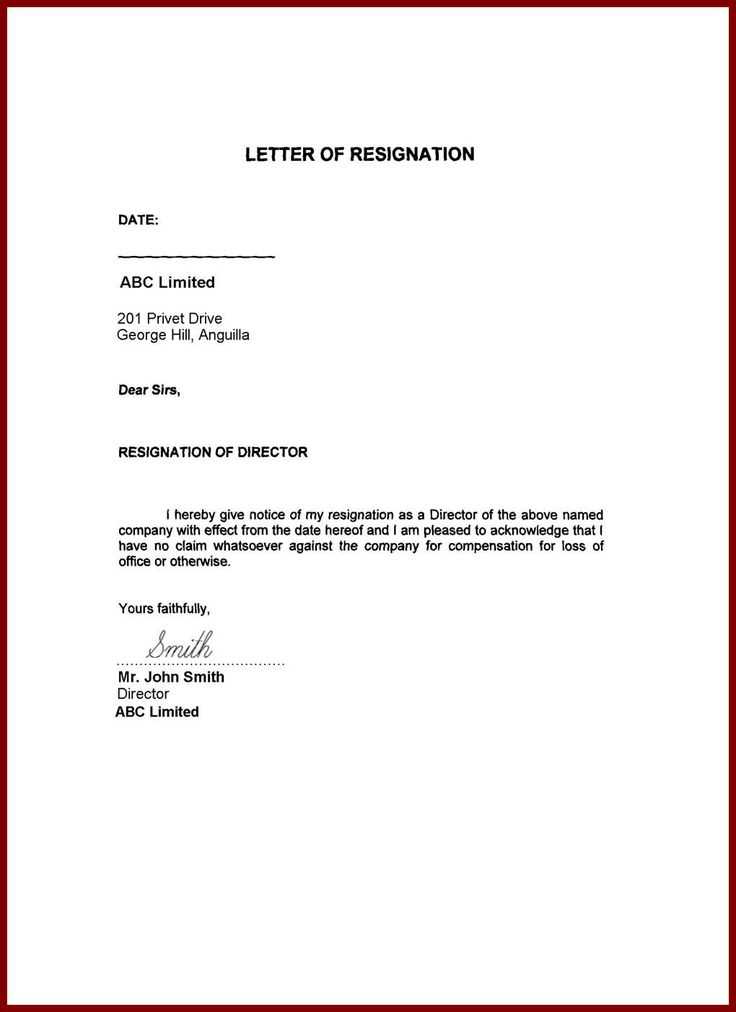
Writing a resignation letter as a company director requires careful attention to both tone and content. This letter needs to be clear, concise, and professional while conveying the necessary information without unnecessary elaboration. Start by stating the resignation date, making it clear when your departure will take effect. A specific date allows for a smooth transition and gives the company ample time to adjust accordingly.
It’s crucial to briefly explain the reason for your decision, but avoid overly personal or detailed accounts. A simple, professional note about personal reasons, career changes, or new opportunities suffices. If applicable, offer support during the transition period, such as helping with finding a successor or assisting with ongoing projects, to leave on a positive note.
Conclude by expressing gratitude for the opportunity to lead the company, acknowledging the team, or mentioning any accomplishments you are proud of. Always end with a formal closing and your signature. Keep the letter brief, straightforward, and free of any language that could be interpreted as negative or unprofessional.
Here’s the revised version:
When resigning as a company director, ensure your letter is clear, concise, and professional. Start by addressing the appropriate person, typically the board of directors or the company secretary. State your resignation explicitly and include the date when it will take effect. Mention your reasons briefly, if appropriate, without going into unnecessary details.
Key Elements to Include
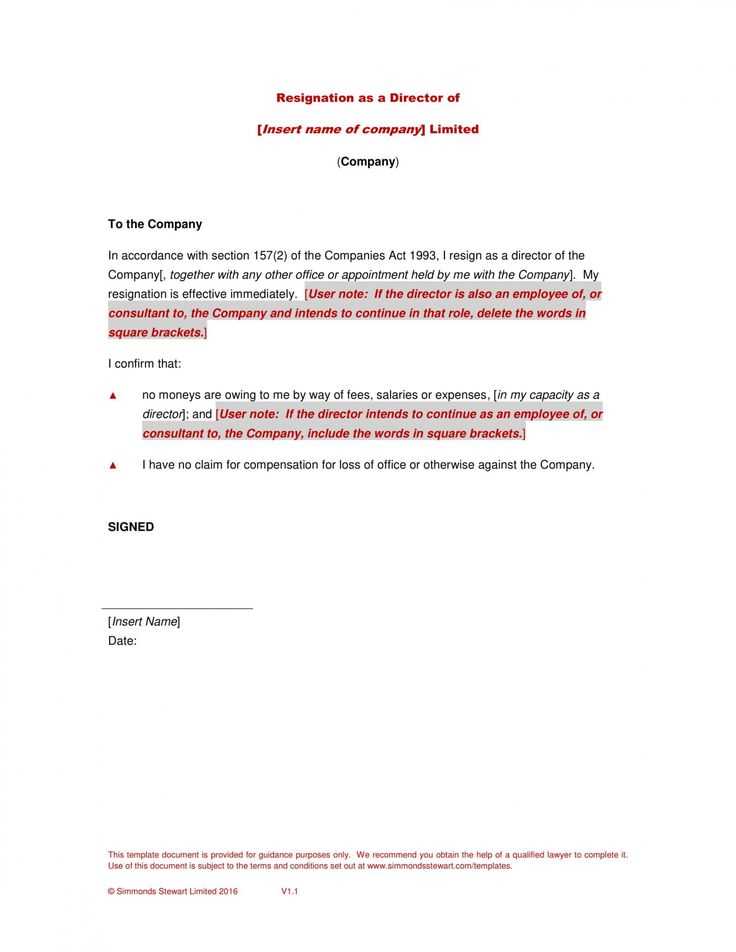
Make sure your letter includes the following:
1. Your name and position.
2. The date of your resignation.
3. A short mention of the reason (optional).
4. Gratitude for the opportunity to serve the company.
5. A willingness to help with the transition process if needed.
Example
Dear [Recipient’s Name],
After careful consideration, I am writing to formally resign from my position as Director of [Company Name], effective [Date]. I appreciate the chance to have been part of this team and wish the company continued success in the future.
If there is anything I can do to assist with the transition, please do not hesitate to reach out.
Best regards,
[Your Full Name]
- Company Director Resignation Letter Template
Begin by clearly stating your intent to resign from the role of company director. This avoids any confusion or ambiguity and sets the tone for the rest of the letter. For example:
[Date]
To [Recipient’s Name],
I am writing to formally resign from my position as Director of [Company Name], effective [Date].
Next, provide a brief explanation for your decision. Keep it professional and concise. If you are moving on to another opportunity, you can mention it without going into unnecessary detail.
Due to personal reasons, I have decided to step down from my role. I believe this is the best decision for both myself and the company at this time.
Offer to assist with the transition, as this will show your willingness to make the process smoother for the company. You can mention your availability to help with finding a replacement or providing support during the handover.
I am happy to assist in any way to ensure a smooth transition and to help with the handover of responsibilities.
End the letter on a polite note, expressing your gratitude for the opportunity to serve as director. This leaves the door open for future positive relationships with the company.
Thank you for the opportunity to serve as Director of [Company Name]. I wish the company continued success moving forward.
Finish with a professional sign-off:
Sincerely,
[Your Name]
How to Address the Resignation Professionally
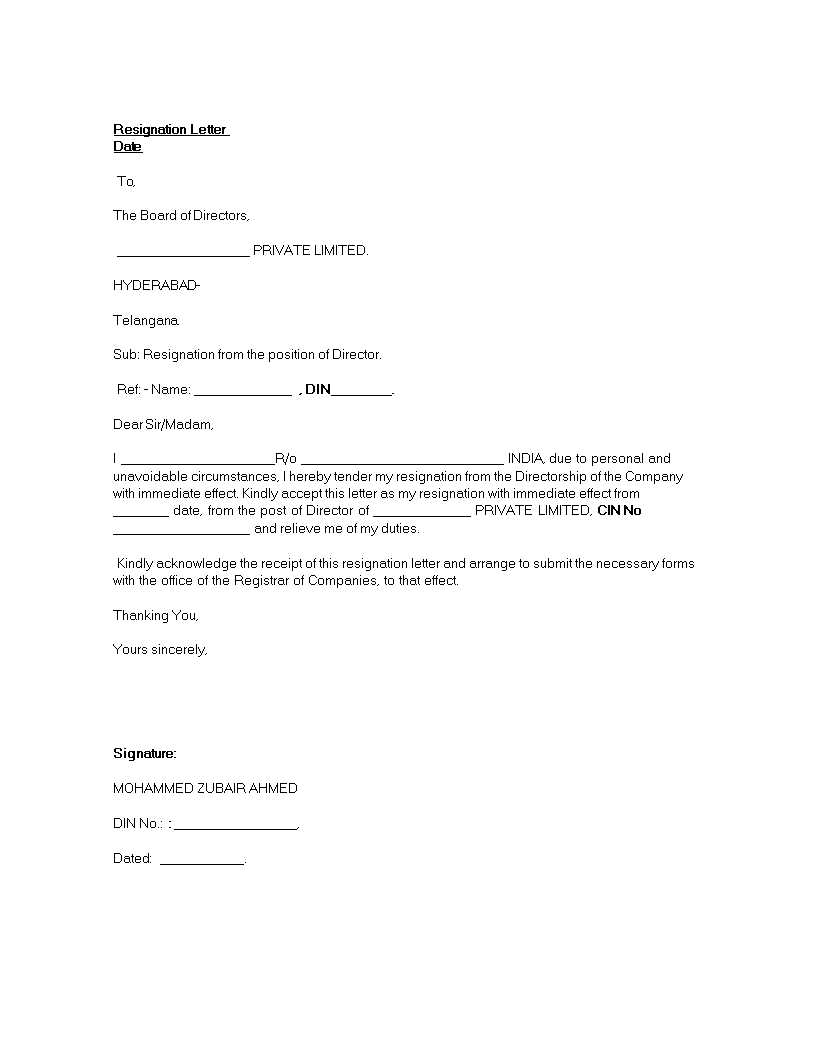
Maintain a calm, respectful tone in your resignation letter. Start by acknowledging the position you are resigning from and expressing gratitude for the opportunity to work with the company. Ensure the tone remains polite and positive, even if your experience was not ideal.
Be Clear and Concise
- State your intention to resign clearly, with the effective date of your departure.
- Include any necessary details, like the reason for your decision, if appropriate. Keep it brief and professional.
- Avoid lengthy explanations or unnecessary details that could cloud the main message.
Show Gratitude
- Thank your employer for the opportunity and the experiences you’ve gained during your tenure.
- If possible, mention specific people or teams that made your time with the company memorable.
End your resignation letter with an offer to help during the transition period. This shows professionalism and a willingness to support the company even as you move on to new opportunities.
Make sure to include the following key points in your resignation letter for clarity and professionalism:
- Date of Resignation: Clearly state your resignation date. This helps the company understand your timeline and make necessary adjustments. Typically, a two-week notice is standard unless otherwise specified in your contract.
- Reason for Resignation: While it’s not mandatory to explain why you are leaving, providing a brief and respectful reason can help maintain positive relations with the company.
- Appreciation for the Opportunity: Even if your time with the company wasn’t ideal, express gratitude for the opportunity to work there. It leaves a good impression and reflects well on your professionalism.
- Offer to Help with the Transition: Mention your willingness to assist with the handover process. This could include training your replacement or providing documentation for ongoing projects.
- Contact Information: Ensure your employer knows how to reach you after your resignation. This is helpful for follow-up questions or references in the future.
- Formal Closing: End your letter with a polite and professional closing. Avoid being overly casual, even if you’re on friendly terms with your employer.
Clearly stating your resignation date is a critical part of a professional resignation letter. Avoid ambiguity and make sure the company has a clear understanding of when you plan to leave. Use precise language to avoid confusion. For example, write “I am resigning from my position effective on [date],” rather than leaving the date implied. This simple structure ensures that your resignation date is crystal clear and will help your employer plan for your departure accordingly.
Be Specific with Your Date
Provide a specific calendar date for your last working day. This avoids any uncertainty or misunderstandings. If possible, mention the day of the week, like “I will be resigning effective Friday, March 15, 2025,” which eliminates any chances of ambiguity regarding the timing. Make sure the date is realistic, taking into account your contractual obligations, notice period, and any planned holidays or leave days.
Include a Notice Period
Check your contract to see if a specific notice period is required. Typically, the notice period ranges from two weeks to a month. In your resignation letter, state the length of the notice period clearly. For instance, “I will complete my notice period of [X weeks/months], with my last day of work being [specific date].” This shows respect for your responsibilities while giving your employer time to prepare for your departure.
Resignation Date Table Example
| Notice Period | Resignation Date | Last Working Day |
|---|---|---|
| 2 Weeks | March 1, 2025 | March 15, 2025 |
| 1 Month | March 1, 2025 | April 1, 2025 |
This approach helps avoid confusion, keeps the process transparent, and shows professionalism. Be sure that your resignation date matches the terms of your employment contract and discuss any necessary transitions with your employer. A clear resignation date will facilitate a smoother handover process and maintain your professional reputation.
Be clear and concise when sharing the reason for your resignation. If the reason is personal or related to career growth, mention it briefly without going into excessive detail. A simple statement like “I have accepted an opportunity that aligns with my long-term career goals” can suffice. If the reason involves circumstances within the company, focus on the positive aspects of your experience and avoid negative comments. You can say something like “I have decided to pursue a new direction that better fits my personal aspirations” without criticizing the company. Keep the tone professional and maintain a sense of appreciation for the opportunity you’ve had.
Provide clear communication channels. Ensure the outgoing director communicates directly with their successor, introducing them to key team members and outlining current projects. Share insights into operational procedures and strategic goals to minimize disruption.
Facilitate Knowledge Transfer
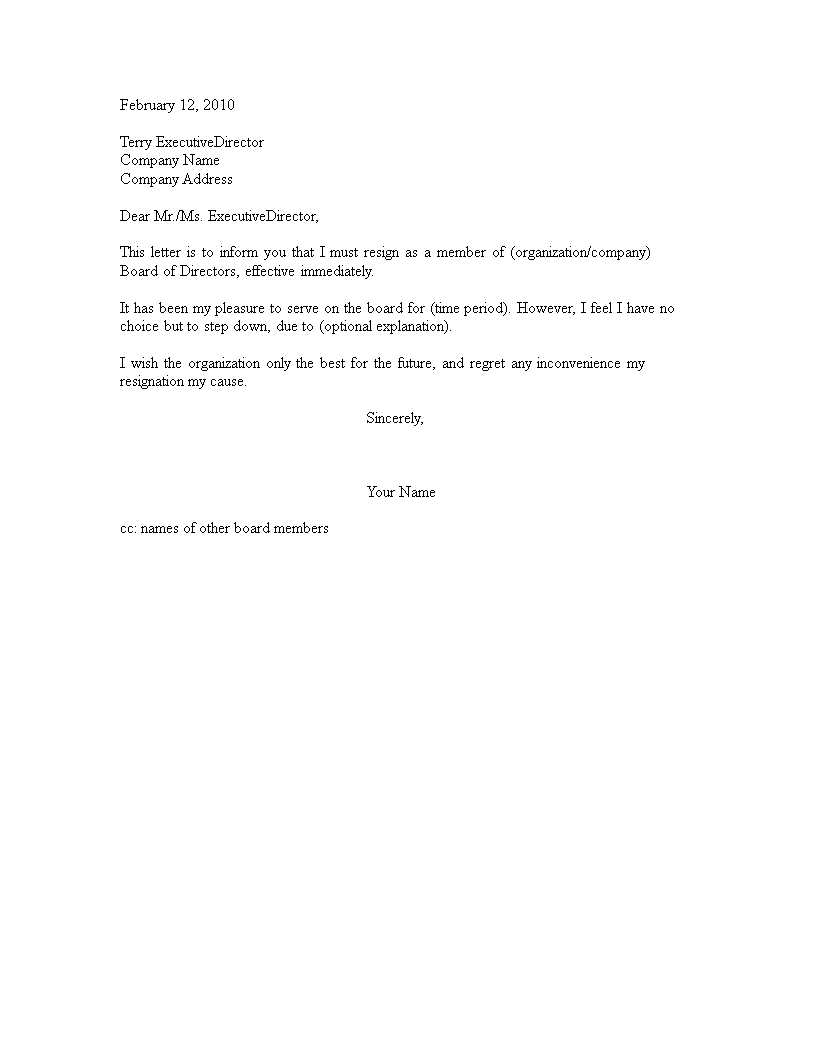
Arrange meetings or handover sessions between the departing director and the new one. Create detailed documentation on ongoing initiatives, pending decisions, and upcoming deadlines to support the transition. This will help the new director step in without missing a beat.
Encourage Team Collaboration
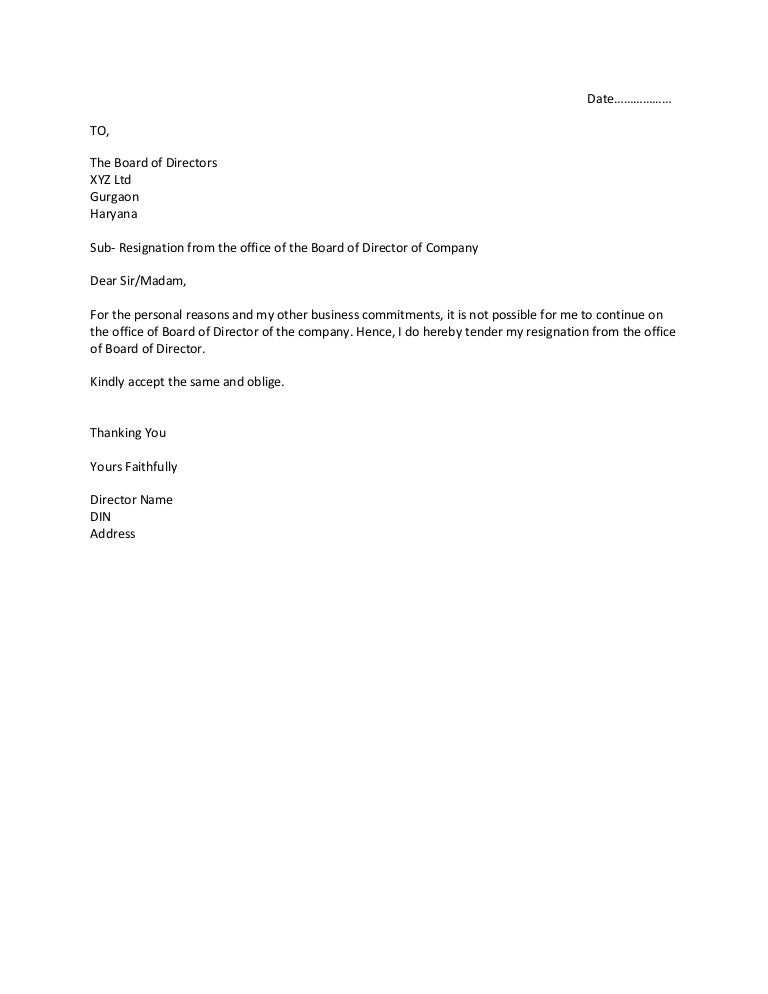
Foster an environment of cooperation by introducing the incoming director to the team in a positive manner. Encourage open dialogue, highlighting team strengths and areas for improvement. It’s crucial that both the new leader and staff feel supported throughout the change process.
End your resignation letter on a positive note. Thank the company for the opportunity and the experiences you’ve gained during your time there. This will leave a lasting impression of professionalism and goodwill. A brief, sincere thank you shows respect and appreciation for your colleagues, supervisors, and the company’s support.
Express Specific Gratitude
Instead of using a general “thank you,” specify what you are grateful for. Mention particular projects, team collaborations, or skills you developed. This personal touch strengthens your relationship with the company and highlights your commitment during your tenure.
Conclude with Best Wishes
Leave the door open for future connections. Close your letter by wishing the company success in its future endeavors. This positive conclusion helps maintain professional ties, ensuring that you part ways amicably.
By closing with gratitude and good wishes, you ensure your resignation letter reflects your professionalism and respect for the company, setting a tone for future interactions.
Resigning as a Company Director: What to Include in Your Letter
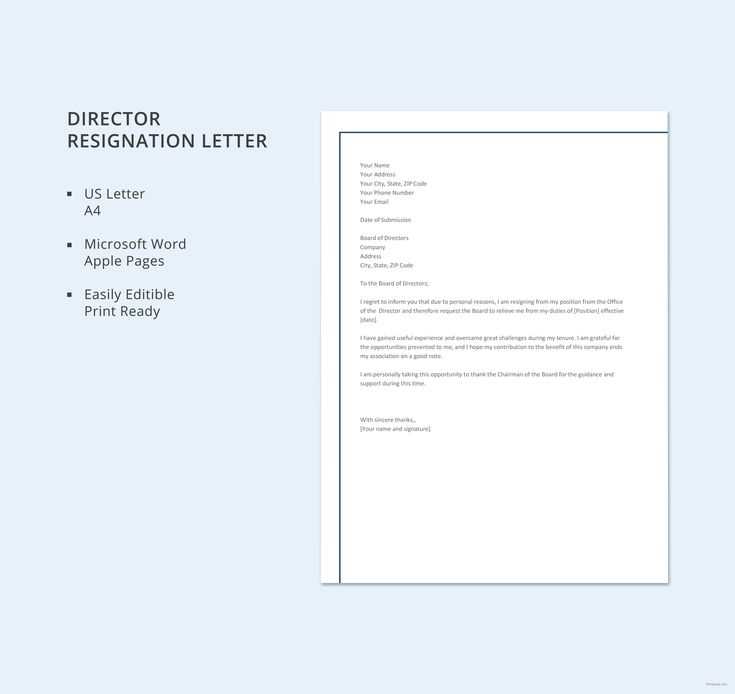
Make sure your resignation letter is clear, direct, and professional. Begin with a formal statement of your resignation and include the effective date. Avoid any ambiguity–state when your resignation will take place. For example:
“I hereby resign from my position as Director of [Company Name], effective [Date].”
Express Gratitude, But Keep It Concise
While you may feel the need to thank the company for the opportunity, keep this section brief. A simple, sincere expression is enough:
“I appreciate the opportunity to have served as a Director and have enjoyed contributing to the company’s growth.”
Offer Transition Assistance
Be proactive about ensuring a smooth transition. Offer help in finding or training your replacement if appropriate:
“I am available to assist with the transition process and will ensure all ongoing projects are handed over properly.”
Conclude your letter by reinforcing your availability during the transition period and expressing best wishes for the company’s future. Finish with a formal closing:
“Sincerely, [Your Full Name]”